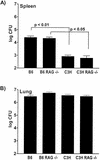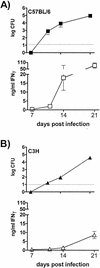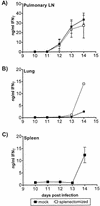Dissemination of Mycobacterium tuberculosis is influenced by host factors and precedes the initiation of T-cell immunity
- PMID: 12117962
- PMCID: PMC128141
- DOI: 10.1128/IAI.70.8.4501-4509.2002
Dissemination of Mycobacterium tuberculosis is influenced by host factors and precedes the initiation of T-cell immunity
Abstract
We report that dissemination of Mycobacterium tuberculosis in the mouse is under host control and precedes the initiation of T-cell immunity. Nine to eleven days after aerosol inoculation, M. tuberculosis disseminates to the pulmonary lymph nodes (LN), where M. tuberculosis-specific T cells are detected 2 to 3 days thereafter. This indicates that the initial spread of bacteria occurs via lymphatic drainage and that the acquired T-cell immune response is generated in the draining LN. Dissemination to peripheral sites, such as the spleen and the liver, occurs 11 to 14 days postinfection and is followed by the appearance of M. tuberculosis-specific T cells in the lung and the spleen. In all cases studied, dissemination to the LN or the spleen preceded activation of M. tuberculosis-specific T cells in that organ. Interestingly, bacteria disseminate earlier from the lungs of resistant C57BL/6 mice than from the lungs of susceptible C3H mice, and consequently, C57BL/6 mice generate an immune response to M. tuberculosis sooner than C3H mice generate an immune response. Thus, instead of spreading infection, early dissemination of M. tuberculosis may aid in the initiation of an appropriate and timely immune response. We hypothesize that this early initiation of immunity following inoculation with M. tuberculosis may contribute to the superior resistance of C57BL/6 mice.
Figures







References
-
- Behar, S. M., T. A. Podrebarac, C. J. Roy, C. R.Wang, and M. B. Brenner. 1999. Diverse TCRs recognize murine CD1. J. Immunol. 162:161-167. - PubMed
-
- Belkaid, Y., S. Mendez, R. Lira, N. Kadambi, G. Milon, and D. Sacks. 2000. A natural model of Leishmania major infection reveals a prolonged “silent” phase of parasite amplification in the skin before the onset of lesion formation and immunity. J. Immunol. 165:969-977. - PubMed
-
- Bosio, C. M., D. Gardner, and K. L. Elkins. 2000. Infection of B cell-deficient mice with CDC 1551, a clinical isolate of Mycobacterium tuberculosis: delay in dissemination and development of lung pathology. J. Immunol. 164:6417-6425. - PubMed
Publication types
MeSH terms
Grants and funding
LinkOut - more resources
Full Text Sources
Other Literature Sources

